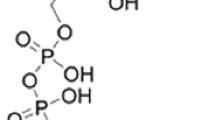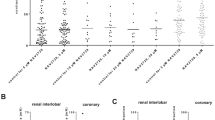Abstract
Cultured endothelium derived from three microvascular fractions of human brain was used to characterize adrenergic receptors coupled to adenylate cyclase activity. Catecholamines (norepinephrine, epinephrine) and their analogs (isoproterenol, phenylephrine, 6-fluoronorepinephrine) dose-dependently stimulated endothelial production of cAMP. Antagonists for ß1 and ß2receptors (propranolol, atenolol, and butoxamine) and for α1-receptors (prazosin) dose-dependently blocked cAMP formation induced by the tested adrenergic agonists. Clonidine, an ga2>α1-agonist, also inhibited isoproterenol-stimulated production of cAMP while yohimbine (α2>α1 antagonist) augmented the norepinephrine or epinephrine-induced accumulation of cAMP. Cholera toxin-induced ADP ribosylation of the stimulatory guanine nucleotide binding protein (Gs) abolished the stimulatory effect of norepinephrine, epinephrine, phenylephrine or 6-fluoronorepinephrine on cAMP formation. ADP ribosylation of the inhibitory guanine nucleotide binding protein (Gi) by pertussis toxin had no effect on either phenylephrine-or 6-fluoronorepinephrine-induced production of cAMP while it increased the norepinephrine and epinephrine-induced accumulation of cAMP. These findings represent the first documentation of ß1-, ß2-, α1 and α 2-adrenergic receptors linked to adenylate cyclase in endothelium derived from human brain microvasculature. These data also indicate that activation of endothelial α1 -adrenergic receptors is mediated by a signal transduction mechanism associated with Gs protein. The results strongly support the presence of various receptor-controlled adrenergic regulatory mechanisms on human cerebromicrovascular endothelium.
Similar content being viewed by others
References
Avissar, S., and Schreiber, G. (1990). Carbamylcholine inhibits ß-adrenergic receptor-coupled Gs protein function proximal to adenylate cyclase.Fed. Eur. Biol. 260:95–97.
Bacic, F., Uematsu, S., McCarron, R.M., and Spatz, M. (1991). Dopaminergic receptors linked to adenylate cyclase in human cerebromicrovascular endothelium.J.Neurochem. 57:1774–1780.
Cash, R., Lasbennes, F., Sercombe, R., Seylaz, J., and Agid, Y. (1985). Adrenergic receptors on cerebral microvessels in control and Parkinsonian subjects.Life Sci. 37:531–536.
Durieu-Trautmann, 0., Foignant, N., Strosberg, A.D., and Couraund, P.O. (1991). Coexpressionof ß1-and ß2-adrenergic receptors on bovine capillary endothelial cells in culture.J. Neurochem. 56:775–781.
Ferrari-DiLeo, G., and Potter, T. L. (1980). α-Adrenoreceptors and muscarinereceptors in human pial arteries and microvessels: A receptor binding study.J.Cereb. Blood Flow Metab. 5:458–464.
Gerhard, D.Z., Broderius, M.A., and Drewes, L.R. (1988). Cultured human and canine endothelial cells from brain microvessels.Brain Res. Bull. 21:785–793.
Hardebo, J.E., and Owman C.L. (1980). Barrier mechanisms for neurotransmitter monoamines and their precursors at the blood-brain barrier interface.Ann. Neurol. 8:1–11.
Harik, S.I., and McGunigal, T., Jr. (1984). The protective influence of the locus coeruleus on the blood-brain barrier.Ann. Neurol. 15:568–574.
Harik, S.I., Sharman, K.V., Wetherbee, R., Warren, R.H., and Banerjee, S.H. (1980). Adrenergic receptors of cerebral microvessels.Eur. J. Pharmacol. 61:207–208.
Hartman, K., Zide, D., and Udenfriend, S. (1972). The use of dopamine beta-hydroxylase as a marker for the central noradrenergic nervous system in rat brain.Proc. Natl. Acad. Sci. USA 69:2722–2726.
Hartman, B.K., Swanson, L.W., Raichle, M.E., Preskorn, S.H., and Clark, H.B. (1980). Central adrenergic regulation of cerebral microvascular permeability and physiological evidence.Adv. Exp. Med.Biol. 131:113–126.
Head, R.J., Hjelle, J.T., Jarrott, B., Berkowitz, B., Cardinale, G., and Spector, S. (1980). Isolated brain microvessels: Preparation, morphology, histamine and catecholamine contents.Blood Vessels 17:173–186.
Herbst, T.J., Raichle, M.E., and Ferrandelli, J.A. (1979). Beta-adrenergic regulation of adenosine 3'5'-monophosphate concentration in brain microvessels.Science 204:330–332.
Huang, M., and Drummond, G.I. (1979). Adenylate cyclase in cerebral microvessels: action of guanine nucleotides, adenosine and other agonists.Mol. Pharmacol 16:462–472.
Johnson, R.D., and Minneman, K.P. (1987). Differentiation of α1-adrenergic receptors linked to phosphatidylinositol turnover and cyclic AMP accumulation of rat brain.Mol. Pharmacol. 21:239–246.
Kalaria, R.N., and Harik, S.I. (1989). Evidence for innervation of cerebral microvessels by locus ceruleus noradrenergic neurons. In Seylaz, J., and McKenzie, E.T. (eds),Neurotransmission and Cerebrovascular Function. Excerpta Medica, Amsterdam-New York, pp. 191–194.
Karnushina, I.L., Spatz, M., and Bembry, J. (1982). Cerebral endothelial cell culture. I. The presence of ß2-and ß2-adrenergic receptors linked to adenylate cyclase activity.Life Sci. 30:849–858.
Karnushina, I.L., Spatz, M., and Bembry, J. (1983). Cerebral endothelial cell culture. II. Adenylate cyclase response to prostaglandins and their interaction with the adrenergic system.Life Sci. 32:1427–1435.
Kobayashi, H., Maoret, T., Ferrante, M., Spano, P.F., and Trabucchi, M. (1981a). Subtypes of beta-adrenergic receptors in rat cerebral microvessels.Brain Res. 220: 194–198.
Kobayashi, H., Memo, M., Spano, P.F., and Trabucchi, M. (1981b). Identification of ß-adrenergic receptors on human cerebral microvessels.Neurology 32:1384–1387.
Lou, H.C. (1989). Innervation of the cerebral vasculature and its putative role in the coupling of flow to metabolism. In Battaini, F., Govoni, S., Magnoni, M.S., and Trabucchi, M. (eds.).Regulatory Mechanisms of Neuron to Vessel Communications in the Brain. Berlin, Springer-Verlag, pp 75–79.
Lowry, O.H., Rosenbough, N.U., Farr, A.L., and Randall, R. J. (1951). Protein measurement with the folin phenol reagent.J.Biol.Chem. 193:265–275.
Minneman, K.P. (1982). α1-Adrenergic receptor subtypes, inositol phosphates, and source of cell Ca2+.Pharmacol. Rev. 40:87–119.
Nakai, K., Itakura, T., Naka, Y., Nakakita, K., Kamei, I., Imai, H., Yokote, H., and Komai, N. (1986). The distribution of adrenergic receptors in cerebral blood vessels: an autoradiographic study.Brain Res. 381:148–152.
Nathanson, J.A. (1980). Cerebral microvessels contain a beta2-adrenergic receptor.Life Sci. 26:1793–1799.
Nathanson, J.A., and Glaser, G.H. (1979). Identification of beta-adrenergic sensitive adenylate cyclase in intracranial blood vessels.Nature 278:567–569
O'Neill, C., Fowler, C.J., Marcusso, J.O., and Winblad, B. (1988). Adrenergic, serotoninergic, histaminergic and imipramine binding sites in post-mortal human microvessel preparations.J. Neural Transm. 73:177–189.
Owman, Chr. (1983). Autonomic innervation of blood vessels with special emphasis on human cerebrovascular nerves and corresponding amine receptors.Gen. Pharmacol. 14:17–20.
Palmer, G.C. (1986). Neurochemical coupled action of transmitters in the microvasculature of the brain. Neurosci.Biobehav. Rev. 10:79–101,1986.
Palmer, G.C., and Palmer, S. (1983). Adenylate cyclase sensitivity to catecholamines and forskolin in rat pia-arachnoid and cerebral microvessels.Neuropharmacology 22:213–219.
Palmer, G.C., McCreedy, S.A., and Freedman, L.R. (1989). Neurotransmitter coupled responses in the microvasculature of the brain under normal and pathological conditions. In Battaini, F., Govoni, S., Magnoni, M.S., and Trabucchi, M. (eds.),Regulatory Mechanisms of Neuron to Vessel Communication in the Brain, Springer-Verlag, Berlin, pp. 113–143.
Peroutka, S.J., Moskowitz, M.A., Reinhard, J.F., Jr., and Snyder, S.H. (1980). Neurotransmitter receptor binding in bovine cerebral microvessels.Science (Wash., D.C.) 208:610–612.
Preskorn, S.H., Hartman, B.H., Raichle, M.E., Swanson, L.W., and Clark, H.B. (1980). Central adrenergic regulation of cerebral microvascular permeability and blood flow: Pharmacological evidence.Adv. Exp. Med. Biol. 131:127–138.
Raichle, M.E., Hartman, B.K., Eichling, J.O., and Sharpe, L.G.P. (1975). Central noradrenergic regulation of cerebral blood flow and vascular permeability.Proc. Natl Acad. Sci. USA 72:3726–3730.
Renneis, M.L., and Nelson, E. (1975). Capillary innervation in the mammalian central nervous system: An electron microscopic demonstration.Am. J. Anal. 144:233–241.
Spatz, M. (1986). Recent advances in the study of cerebrovascular receptors. In Baethman, A., Go, K.G., and Unterberg, A. (eds.),Mechanisms of Secondary Brain Damage, Plenum Publishing, New York, pp. 283–294.
Spatz, M., and Mrsulja, B.B. (1982). Progress in cerebral microvascular studies related to the function of the blood-brain barrier.Adv. Cell. Neurobiol. 3:311337.
Spatz, M., Bacic, F., McCarron, R.M., Merkel, N., Uematsu, S., Long, D., and Bembry, J. (1989). Human cerebromicrovascular endothelium studies in vitro.J. Cereb. Blood Flow Metab. 9 (Suppl.1): S393
Spatz, M., Kaneda, N., Sumi, C., Nagatsu, I., Creveling, C.R., and Nagatsu, T. (1986). The presence of catechol-O-methyltransferase activity in separately cultured cerebromicrovascular endothelial and smooth muscle cells.Brain Res. 381:363–387.
Swanson, L.W., Connelly, M.A., and Hartman, M.A. (1977). Ultrastructural evidence for central monoaminergic innervation of blood vessels in the paraventricular nucleus of the hypothalamus.Brain Res. 136:166–173.
Vanhoutte, P.M. (1987).Endolhelium-Dependent Relaxing and Contracting Factors. Clifton, N.J., Humana Press.
Van Zwieten, P.A. (1988). The role of adrenoreceptors in circulatory and metabolic regulation.Am. Heart J. 116:1384–1392.
Westergaard, E. (1975). The effect of serotonin, norepinephrine and cyclic AMP on the blood-brain barrier.J.Ultrastruct. Res. 50:383.
Wroblewska, B., Spatz, M., Merkel, N., and Bembry, J. (1984). Cerebrovascular smooth muscle culture, II. Characterization of adrenergic receptors linked to adenylate cyclase.Life Sci. 34:783–791.
Zeleznikar, R.J., Jr., Quist, E.E., and Drewes, L.R. (1983). An alphal-adrenergic receptor-mediated phosphatidylinositol effect in canine cerebral microvessels.Mol. Pharmacol. 24:163–167.
Author information
Authors and Affiliations
Rights and permissions
About this article
Cite this article
Bacic, F., McCarron, R.M., Uematsu, S. et al. Adrenergic receptors coupled to adenylate cyclase in human cerebromicrovascular endothelium. Metabolic Brain Disease 7, 125–137 (1992). https://doi.org/10.1007/BF01000158
Received:
Accepted:
Issue Date:
DOI: https://doi.org/10.1007/BF01000158




